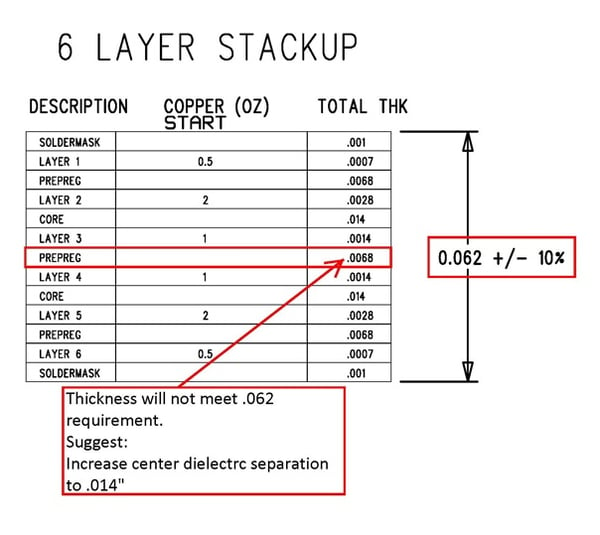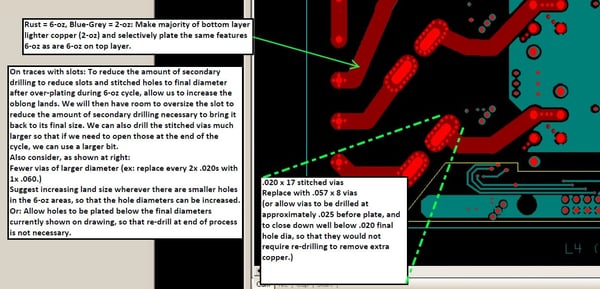Your PCB design for manufacturing is critical to the success of your final application. Design features which make your board difficult to build add cost to your product, either by slowing down the production process, or by increasing the scrap rate.
PCB Design for Manufacturability (DFM) is an absolute necessity on highly unusual printed circuit boards, but it is also useful to review with even slightly more complex than average boards. Reviewing helps to identify and eliminate as many difficulties as possible ahead of manufacturing in order to reduce parts cost and minimize risk during production assembly.
DFM considers the impact of the various design choices used in each project, with an eye towards optimizing the design for trouble-free manufacturing.

Operator-involved, Non-automated DFM Analysis of Drawing Stack-up Showed that the Customer's Stack-up Would Not Meet Their Overall Thickness Requirement. Problem was Reported and Solution was Suggested.
PCB Data File Design Rule Check
All data files undergo a thorough design rule check (DRC) prior to releasing your order for production. DRC is an automated data analysis which compares your design parameters to established process minimums in order to identify and correct potential problem areas.
Typical circuit board DRC violations include insufficient trace width, spacing, or annular ring. The checks are extremely valuable; even one or two seemingly small design errors can lead to an entire order being scrapped. For routine designs, DRC checks alone are usually all that is required to ensure a good yield through production. True DFM, however, takes the process a step further.
Beyond Standard DRC
DFM goes beyond simple design rule check by adding a level of interpretation based on experience. Several items to consider, such as fabrication notes, machining views, and other such customer-specific requirements that fall outside of normal processing limits, are impossible to catch with automatic DRC checks alone. Studying the requirements that fall outside the scope of automated design rule check enables us to report our findings to you for consideration.
We typically provide suggestions we feel will improve manufacturing throughput and accuracy, in addition to meeting your original design intent. Our goal is to have all questions completely addressed so that by the time you place your order we are ready to build exactly what you have ordered on-time, and correct.

DFM Review of Selective Heavy Copper PCB Resulted in Suggestions for a Number of Significant Changes Intended to Improve the Production Yield.
Items Outside DRC Check
Below is a short list of common items outside the scope of automated DRC checks, which we may question because they add cost:
- Non-standard tolerances below industry norms. (Anything from hole diameter tolerances to ionic contamination limits.)
- Non-standard materials. (Typically, specific laminate products which are not stocked, and for which we may offer equivalents, supported by data sheets.)
- Multiple surface finishes (other than gold tabs, which are commonly combined with another finish.)
- Hole wall copper thickness in in excess of IPC Class 3 standards (typically, copper heavier than .001” average.)
- Unusual surface finish thickness requirements, particularly with gold (often incorrectly expressed, sometimes actually required.)
- Unusual solder mask requirements (color, thickness) Minimum aspect ratio, hole diameter vs. PCB thickness. (Affects ability to plate reliably, requires more time on CNC drill equipment.)
- Edge-plated (“castellated”) half-holes along PCB outline.
- Unusual or unworkable lamination requirements, particularly in combination with buried or blind via drilling sequence.
- Via plugging requirements, when not completely clear.
- Impedance notes that do not match either the Gerber files or the stack-up requirements.
Summary
Please remember, our Design for Manufacturability checks can only be as complete as the information we receive. It’s common to receive only partial data sets or drawings for quoting which may not tell the whole story. Often times we receive information about the purchase order that we did not have at the time when we quoted the order.
If newly received information will affect price or lead time we cannot begin manufacturing until the new items are sorted out. We suggest that whenever possible you supply all relevant information at the time of the quote: Gerber, drill, netlist files, fabrication and panelization drawings, and any requirements not otherwise covered. Complete information helps us quote your opportunity quickly and correctly and enables us to begin production on schedule without unnecessary delays.
Key Takeaways
- DRC catches common errors: Automated design rule checks identify issues such as insufficient trace width, spacing, or annular ring, helping prevent costly scrap and delays.
- DFM adds engineering expertise: Beyond DRC, DFM incorporates interpretation of fabrication notes, machining views, and other requirements that automated tools cannot evaluate.
- Non-standard requirements increase cost: Items like tight tolerances, unusual laminates, multiple surface finishes, or excessive copper thickness often add complexity and expense.
- Special design features require review: Edge plating, buried or blind via sequencing, impedance mismatches, or incomplete via plugging specifications must be clarified before production.
- Complete data upfront is critical: Providing Gerber, drill, netlist, fabrication drawings, and all requirements at the quoting stage avoids price changes, lead time delays, and production hold-ups.

















